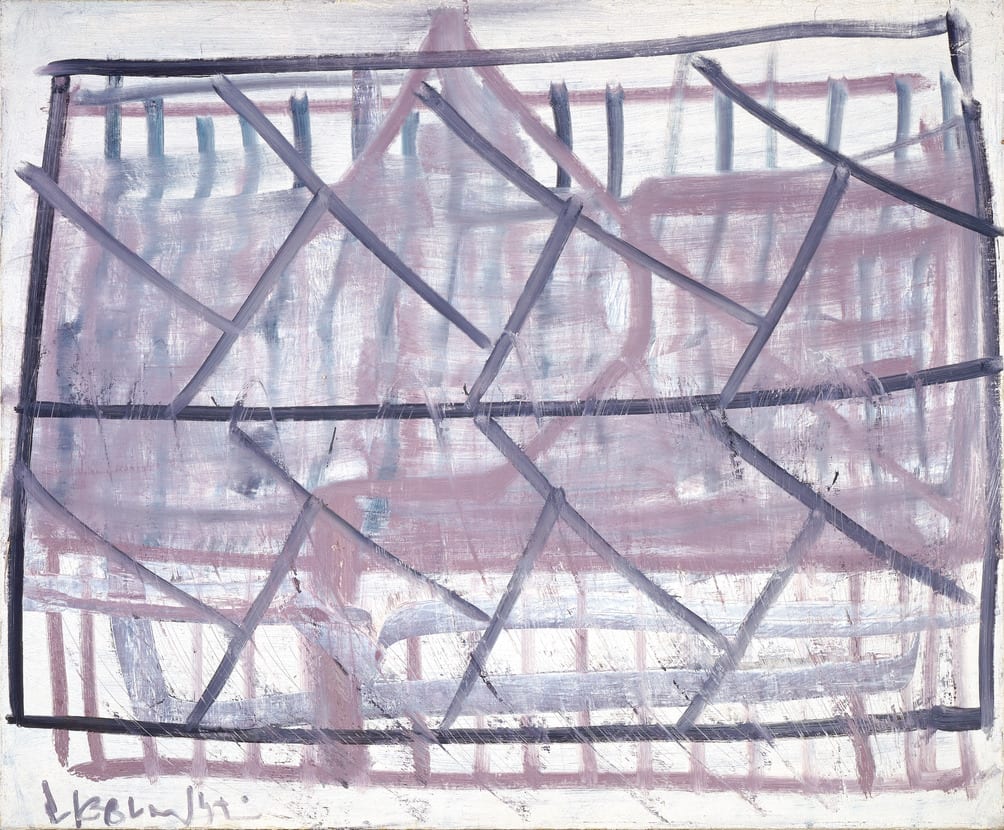
- Artist/Maker:
- Moshe Kupferman
- Bio:
- Israeli, b. Poland, 1926-2003
- Title:
- Untitled
- Date:
- 1974
- Medium:
- Oil on canvas
- Dimensions:
- 51 × 62 1/8 in. (129.5 × 157.9 cm)
- Credit Line:
- Gift of Nitza Etra
- Accession Number:
- 1984-57
Not On View
Largely self-taught and working on a kibbutz in deliberate isolation, Kupferman pursued a personal vision and a style unaffected by other directions and trends in the art world. He invented an abstract visual language of great subtlety. The color of Untitled, as in many other of his paintings, relies upon a palette of purple (for which he is celebrated), green, and gray, in addition to black and white. In this work, the purple suggests a deep mauve to an earthy gray, and the limited number of colors heightens the abstraction of the image. Within a gridlike structure, there is a mechanical reiteration of parallel and intersecting lines in the painting. His expressive gestural lines enhance or negate one another, through what the artist terms "activities." Each activity is a response, and each response results in another; thus, the work is constructed tier by tier. These spiritual landscapes are created through the addition and removal of layers and lines of paint and the interaction between the revealed (overt) and the concealed. The result is a superstructure of painterly activities that the artist has hidden. The final image in Untitled appears to fall between a work of severe Minimalism and one of a more aggressive Expressionism.
Kupferman's hidden past figures strongly in his work, although the artist declined to discuss the connection between his European childhood and adolescence and his later life as a kibbutz member in Israel. Born in eastern Poland, Kupferman was raised in a traditional Jewish family. With the outbreak of World War II, his childhood and formal schooling ended abruptly. Escaping the Nazis, his family fled east to the Soviet Union, where they were interned in work camps in Siberia and central Asia. The only surviving member of his family, Kupferman immigrated to Israel in 1949. A year later, he joined other refugees in the western Galilee, founding a kibbutz (Lohamei Ha-Gettaot) where he lived and worked for over forty years. It has been suggested that the lines in his paintings are a metaphor for the kibbutz fields, or perhaps the scaffolding of those houses in whose construction he took part. Others suggest that his grid is an image that recalls the barbed-wire fences that surrounded concentration camps. Attempts to interpret Kupferman's painting are based on the assumption that the reality is one of personal and historical memory and based on associations, both hidden and overt.
Kupferman's hidden past figures strongly in his work, although the artist declined to discuss the connection between his European childhood and adolescence and his later life as a kibbutz member in Israel. Born in eastern Poland, Kupferman was raised in a traditional Jewish family. With the outbreak of World War II, his childhood and formal schooling ended abruptly. Escaping the Nazis, his family fled east to the Soviet Union, where they were interned in work camps in Siberia and central Asia. The only surviving member of his family, Kupferman immigrated to Israel in 1949. A year later, he joined other refugees in the western Galilee, founding a kibbutz (Lohamei Ha-Gettaot) where he lived and worked for over forty years. It has been suggested that the lines in his paintings are a metaphor for the kibbutz fields, or perhaps the scaffolding of those houses in whose construction he took part. Others suggest that his grid is an image that recalls the barbed-wire fences that surrounded concentration camps. Attempts to interpret Kupferman's painting are based on the assumption that the reality is one of personal and historical memory and based on associations, both hidden and overt.
Information may change as a result of ongoing research.